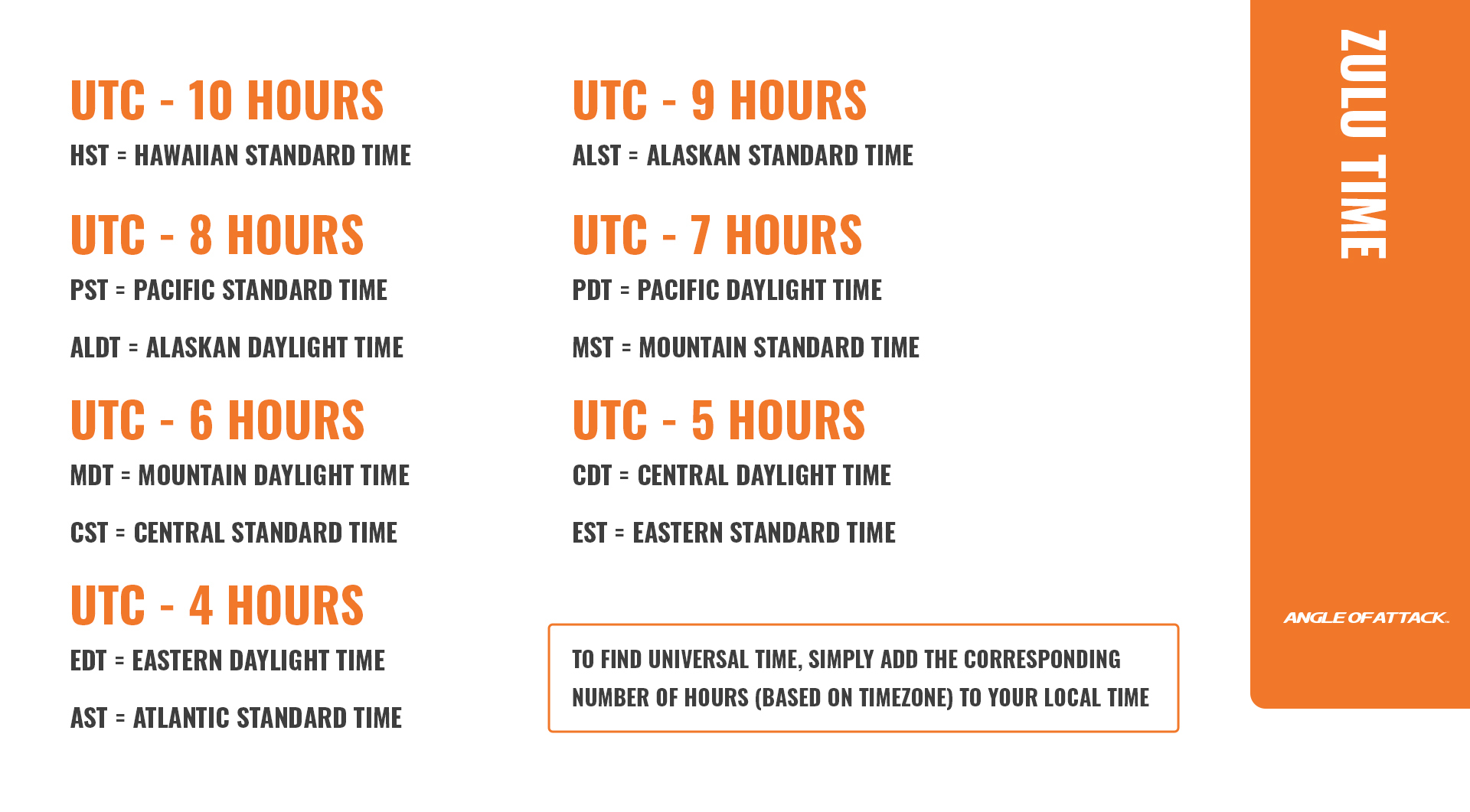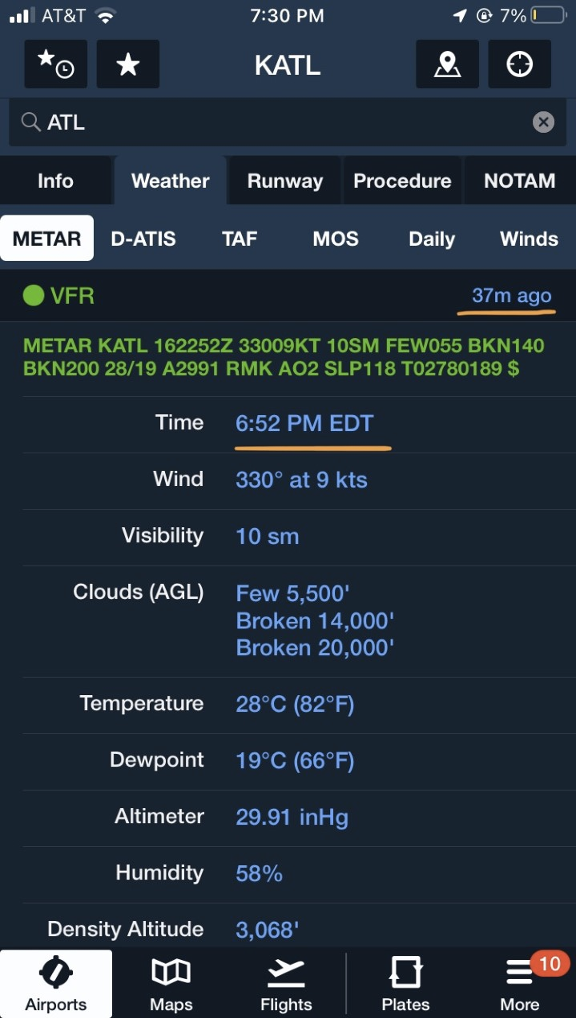
You’ve seen it on the weather charts and likely heard it on the ATIS, but you have no idea what it actually means. You are not alone. Zulu time is a foreign concept, especially for those without military experience. It is an important concept, but once you understand it. It will become fairly easy to translate Zulu time into “normal” time. This article will tell you what Zulu time is, how to calculate it and read it.
What Actually is “Zulu Time” and Why do Pilots Use it?
Zulu time is the military name of Universal Time Coordinated (UTC) and Greenwich Mean Time (GMT). It is a standard time, sometimes referred to as a geographically fixed time, across all time zones. That means while it may be 4:00 PM in Atlanta but 3:00 PM in Fort Worth it is 2100Z in both time zones.
It is based on the time in Greenwich, England. Why Greenwich? Nothing other than it was where the first major center dedicated to navigation, astronomy, and timekeeping was built by King Charles II in 1675. The name “Zulu” is not a special name either. It simply comes from the shortening of “zero meridian time” to “z-time”, which is the military phonetic alphabet is “Zulu”. For a while, when the “z” phonetic abbreviation was “zebra” this was called “Zebra time”. Zulu time’s first major usage was by the Royal Navy in the 19th century.
Zulu time is most often used by the military, pilots, and by mariners. The reason is standardization. For the military, it is extremely important when multiple countries are coordinating across different time zones that events occur at the exact same moment. How many military/action movies you’ve seen where they “synchronize watches”? As ships and airplanes began to cross multiple time zones in one journey it became more and more important to standardize time.
How is Zulu Time Calculated?
How Zulu time is converted to and from local time depends on where you live. Here are some good general steps to calculate Zulu time from your local time. In this example, we’ll convert 2:00 PM Eastern Standard time into Zulu time.
Step 1: Convert local time to a 24-hour time
2:00 PM eastern standard time becomes 14:00. Anytime before 12 noon will just be the same number, so you can practically skip this step.
Step 2: Use the Zulu conversion factor
See table for Zulu conversion. 
Eastern Standard time is five hours behind Zulu time (-5 on the chart) so we add five hours to our local 24-hour time. So 14:00 becomes 1900Z. No “:” is used and the “PM/AM” suffix is replaced with a “Z”.
Two things make calculating Zulu time difficult. The first is illustrated in the conversion chart. The conversion will differ depending on if you are in standard time or daylight savings time. Remember daylight savings time is generally spring to fall. You need to make sure you remember a) what season it is and b) what that does to the conversion number.
What are the challenges of Zulu time?
The second aspect of Zulu time that is difficult is when you are a day behind. For example, let’s take 10:00 PM EST. 10:00 PM EST converts to 20:00 on the 24-hour clock. If we added five to it per the conversion table that would be 2500Z. But that can’t happen. There are always only 24 hours in a day. This is actually 0100Z.
If you’re having a hard time understanding that, remember this Zulu time is in reference to the time in Greenwich, England. When the party starts at 10:00 PM in New York on Friday, the pubs in England are closing down because it’s 1:00 AM the next day, Saturday. Whenever you have trouble with Zulu time, ask yourself: does it make sense for the folks in London to be at this time? All Zulu time is really doing is converting to the 24-hour clock in England.
Angle of Attack’s Online Private Pilot Course leaves no stone left unturned when it comes to Zulu time conversions. With easy-to-understand visuals and graphics, you’ll be converting to Zulu time easily. In fact, some of our students have simply made the switch and abandoned local times in everyday life. (A fun practice around the airport, but much less fun when trying to explain that dinner will be at 2200Z.)
How to Read Zulu Time?
The most common place you will encounter Zulu time is in weather reporting. However, Zulu time is also used in navigation and log book entries. For example, before every flight, you should listen to or read the current METAR, ATIS, or AWOS weather report which is almost always given in Zulu time. Here is an example from August 16th at Atlanta’s Hartsfield-Jackson Airport.
The audio call out on the ATIS will be in a similar format “Atlanta tower information echo, time twenty-two fifty-two Zulu”. For our purposes, the important line is the one immediately after the airport identifier, “162252Z.” In a typed weather report like this, the first two numbers refer to the date of the month the report was taken (August 16th). Next is the Zulu time; 2252Z. Working backward from our conversion above, 2252Z minus four hours is 18:52 on the 24-hour clock, which is 6:52 PM EDT. (August 16th is Eastern Daylight Savings Time in Georgia)
![]()
Why is weather this important?
Well, the weather can change and change very rapidly. Researchers at the University Corporation for Atmospheric Research believe under ideal conditions a small white cloud can develop into a massive cumulonimbus thunderstorm in under an hour. Knowing this, and knowing that weather reports like METARs usually take an hour to update. You can see how a weather report taken 2 min ago is much more trustworthy for a pilot than one taken 52 min ago. Understanding how long a weather report was taken or what time a storm is supposed to arrive requires you to understand Zulu time.

Don’t fret if you are struggling, it’s difficult and often glossed over part of flight school. Some weather reporting and electronic flight bags have started to make it default to convert to local time.
For example, the ForeFlight app has taken the Atlanta information we were looking at and given both the local time and how long ago the report was. Very useful. However, in some situations such as flight briefings the apps haven’t caught on, and converting to Zulu time is still critical.
Again, if you’re having trouble with this niche concept, highly recommend using Angle of Attack’s Online Private Pilot Course. Calculating Zulu time is a pretty important topic not just for navigation, and weather, but as you navigate through your pilot career. Learning to speak in Zulu time is important and practicing conversions is a good way to get better. Good luck and remember, time is of the essence!

Michael Brown grew up flying on the banks of the Tennessee River in Chattanooga, TN. He obtained his private pilot’s license in high school and has instrument and seaplane ratings. Michael graduated from Texas Christian University, where he founded the school’s flying club, with a double major in Business and Communications. He is currently a law student at Tulane University, studying transportation law. Michael was named the Richard Collins Young Writing Award winner and has had his legal writing recognized by the American Bar Association’s Air & Space Subcommittee. When he is not flying or studying, Michael enjoys riding his bike and cheering on his Atlanta Braves.

Stay Connected
Be the very first to get notified when we publish new flying videos, free lessons, and special offers on our courses.





